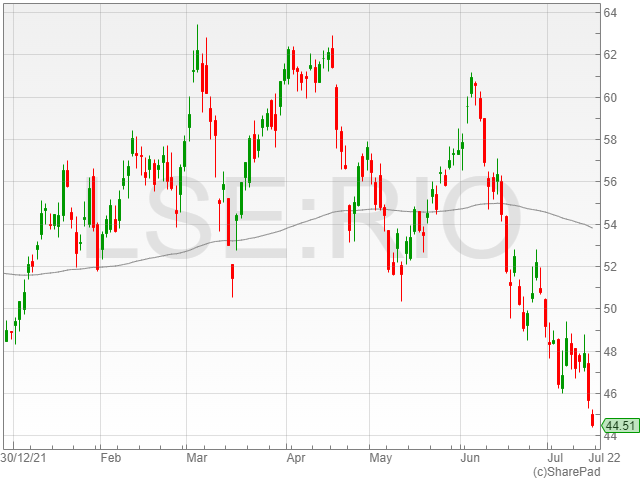Rio Tinto shares declined 2.8% to 93.2p in early morning trading on Friday, after the company reported a weakened economic outlook as a result of the Ukraine war, tighter monetary policy and Covid-19 restrictions in China.
The mining group acknowledged prices for its commodities fell over the period, linked to rising recession concerns and a drop in consumer confidence.
Rio Tinto further mentioned inflationary pressures hitting its supply chains were currently exacerbated by trade disruptions, food protection and the international focus on securing energy supplies.
Rio Tinto Q2 Production
The company also reported its Q2 production results, which included the delivery of its first ore at its Pilbara greenfield mine, Gudai-Darri, and the firing of its first draw bell at its Oyu Tolgoi underground project in June.

“We strengthened our operational performance at a number of sites, which we will now replicate across the portfolio. The delivery of first ore at Gudai-Darri, our first greenfield mine in the Pilbara for over a decade, increases mine capacity and supports production of our flagship Pilbara Blend,” said Rio Tinto CEO Jakob Stausholm.
“We also fired the first draw bell at the Oyu Tolgoi underground project in June, and started producing scandium and tellurium. These critical minerals are being extracted from existing waste streams at our titanium operation in Quebec and copper operation in Utah, without the need for new mining.”
“We are committed to transforming our culture and building better relationships. In May, we signed a Heads of Agreement with the Puutu Kunti Kurrama and Pinikura (PKKP) people which will guide the co-management of PKKP country where mining takes place.”
Rio Tinto reported a 5% growth in its Pilbara iron ore shipments on a 100% basis to 79.9 Mt and a 4% rise in its Pilbara iron ore production to 78.6 Mt against Q2 2021.
The mining company mentioned a 3% increase in Bauxite to 14.1 Mt, a 10% slide in Aluminium to 731 kt and a 9% climb in mined copper to 126 kt.
Rio Tinto also noted a 2% drop in titanium dioxide slag to 293 kt and a 4% fall in IOC iron ore pellets and concentrate to 2.6 Mt.
Production Guidance
The firm commented its iron ore shipments and bauxite production guidance remained subject to weather and market conditions.
The company said its Pilbara shipments guidance remained dependent on ramp-up of Gudai-Darri and Robe Valley, alongside the availability of skilled labour and the mangement of cultural heritage, including any possible impacts from the Aboriginal Cultural Heritage Act 2021.
Rio Tinto confirmed its Pilbara iron ore 2022 unit cost guidance remained unchanged at $19.50 to $21.00 per tonne, with an operating cost guidance based on an Australian dollar exchange rate against the US dollar of 0.71.
Rio Tinto highlighted a Copper C1 unit cost guidance in 2022 of 130 to 150 US cents per pound, remaining unchanged year-on-year.
